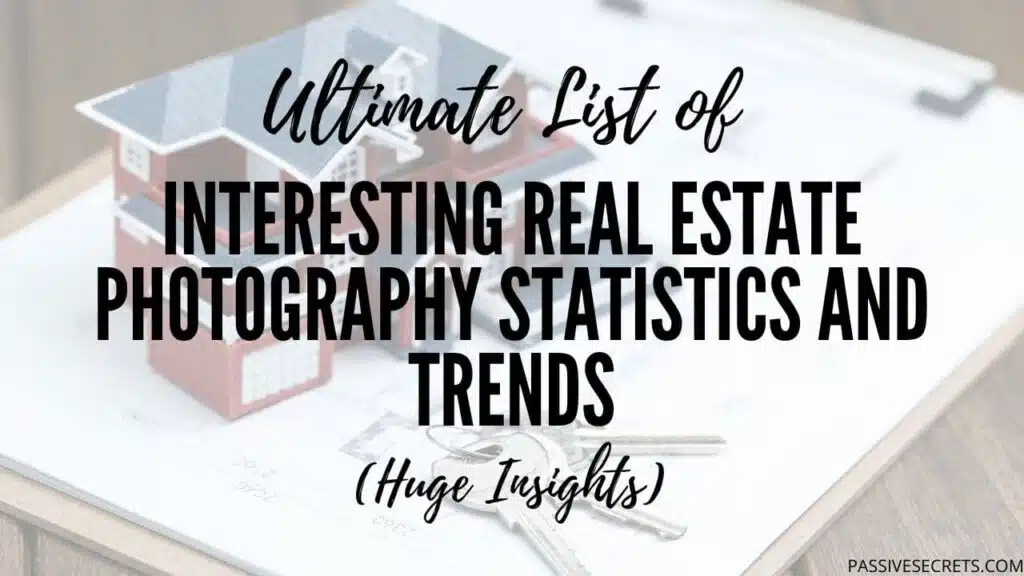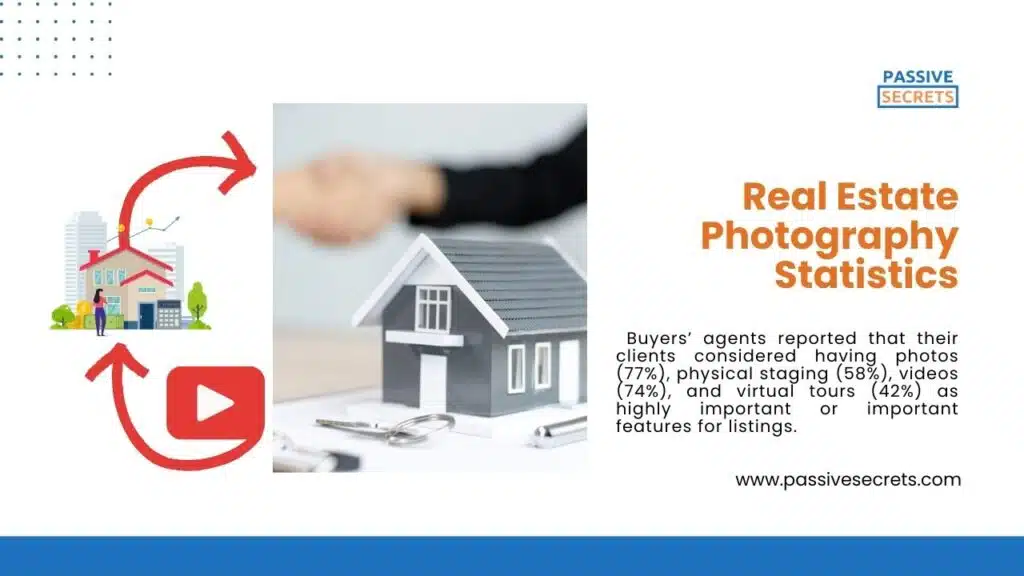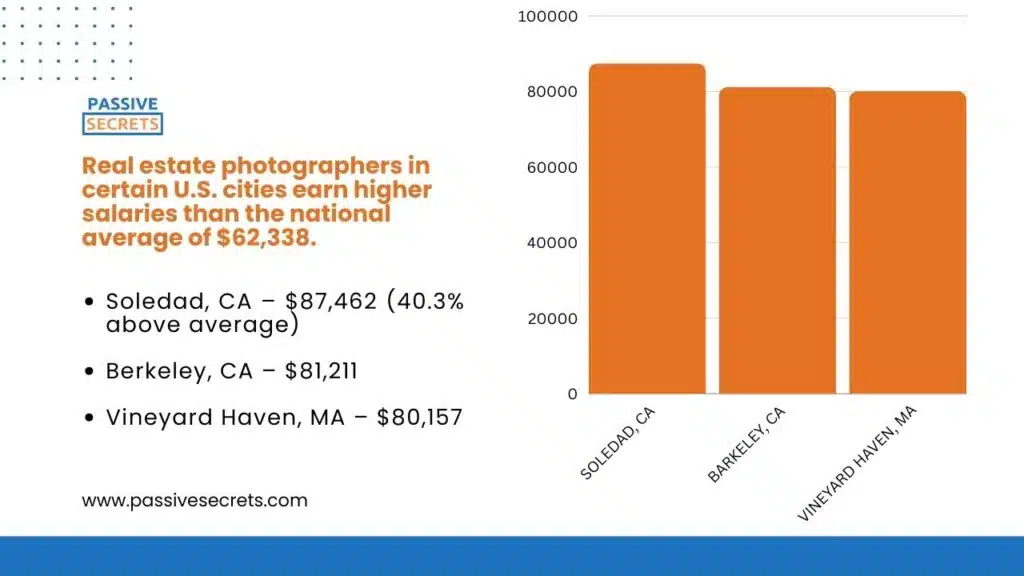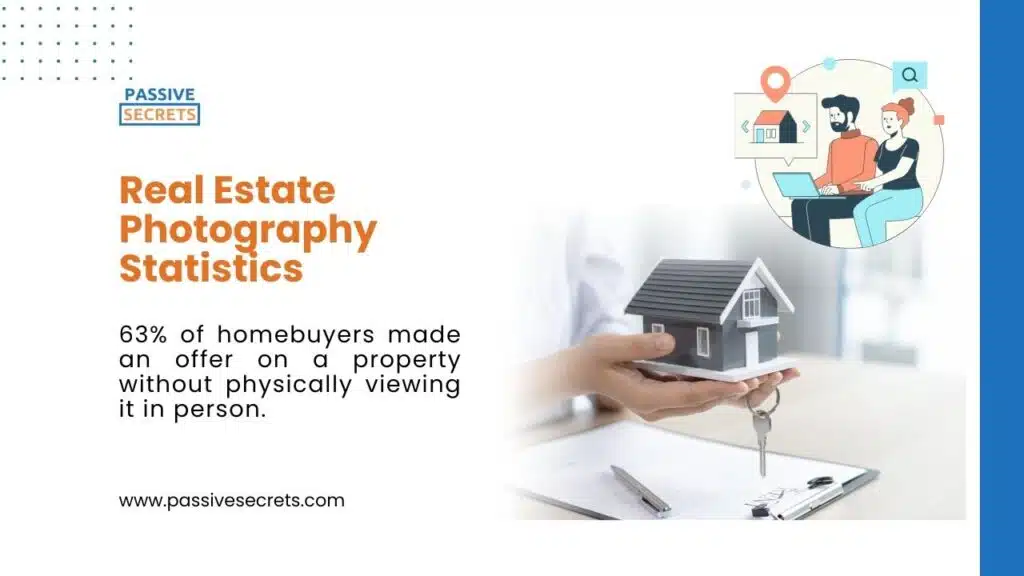
“People are moved by what they see!” This is very true, including for property buyers.
In today’s visual-driven age, captivating visuals are crucial for selling properties quickly and at the right price.
High-quality real estate photography has become a game-changer in the industry, with the power to make or break a potential sale. In fact, 63% of homebuyers made an offer on a property without physically viewing it in person.
But just how impactful is it?
Dive into the latest real estate photography statistics to discover the surprising truth about the role of visuals in real estate marketing, from increased online engagement and viewings to faster sales and higher prices.
Explore the numbers behind the importance of showcasing properties in their best light, and learn how real estate photography can be the key to unlocking success in the competitive world of property sales.
Real Estate Photography Statistics
1. The U.S. real estate photography industry revenue is estimated to reach $268.3 million by 2024. The industry has grown at a CAGR of 0.6% in the past 5 years. (source)
2. In 2024, there are estimated to be over 6,181 employees and 6,891 businesses in the U.S. real estate photography industry. (source)
3. 63% of homebuyers made an offer on a property without physically viewing it in person. (source)
4. Properties with professional photography in their listings sell 32% quicker than those without. (source)
5. Properties featuring aerial photos in their listings sell 68% quicker than those without. (source)
6. Professional photography can increase views by 61% for real estate listings. (source)
7. Video content can boost inquiry rates by a remarkable 403% for real estate listings. (source)
8. Nearly three-quarters (72.2%) of realtors believe that high-quality photography is key to securing more listings. (source)
9. Agents using pro photographers earn $8,683 per sale, double those who don’t ($4,292). (source)
10. High-quality real estate photography helps retain viewer attention for 20 seconds. (source)
11. About 85% of homebuyers consider photos to be the most essential feature on a real estate website. 27% of buyers considered videos the same. Also, 39% consider virtual tours to be the most useful feature of a real estate website. (source)
12. High-quality, professional real estate photography can boost online engagement by up to 118%. This significantly increases the visibility of your property listings and attracts more potential buyers. (source)
13. 40% of property buyers use online video sites as an information source in their home search. (source)

14. Buyers’ agents reported that their clients considered having photos (77%), physical staging (58%), videos (74%), and virtual tours (42%) as highly important or important features for listings. (source)
15. Likewise, sellers’ agents reported that their clients considered having photos (89%), physical staging (44%), and videos (44%) as highly important or important features for listings. (source)
16. Property listings with videos receive four times as many inquiries. Also, nearly 80% of active listing agents utilize drone media, including photos and videos, to showcase their listings. (source)
17. Most home buyers (51%) rely on YouTube as their primary source for researching homes. (source)
18. Virtual tours increase views for property listings by 87%. Meanwhile, 54% of buyers ignore listings without high-quality images. (source)
19. Century 21’s video campaign on social media boosted home sales by 20%. (source)
20. 10% of real estate agents use videos to market homes. (source)
21. Virtual tours boost engagement 5-10x, keeping buyers exploring your listing longer. (source)
22. Only 15% of property listings feature high-quality photos (source)
23. The number of real estate photography businesses in the US rose by 11.5% between 2022 and 2023, going from 5,353 to 5,967 companies. (source)
24. The US real estate photography industry is labor-intensive, with businesses spending most on wages (30.5%), followed by purchases (12.8%) and rent/utilities (5.5%). (source)
25. As of July 15, 2024, real estate photographers in the US earn an average annual salary of $62,338, equivalent to $29.97 per hour, $1,198 per week, or $5,194 per month. (source)
26. Most Realtors (77%) utilize social media for real estate purposes, and nearly half (47%) find it generates the highest quality leads compared to other sources. (source)
27. Real estate photographers in certain U.S. cities earn higher salaries than the national average of $62,338. The top three cities are:
- Soledad, CA – $87,462 (40.3% above average)
- Berkeley, CA – $81,211
- Vineyard Haven, MA – $80,157 (28.6% above average)

These cities offer significantly higher salaries than the national average. (source)
28. More than 60% of UK consumers consider estate agents’ photos to be of low quality. (source)
29. Photographing a typical UK property thoroughly takes approximately 45-60 minutes. (source)
30. Over half of buyers (57%) want to see 8-10 aerial photos per listing, and properties that include drone photography see a significant boost (65%) in in-person viewings. (source)
31. The global drone photography market was valued at $617.6 million in 2023 and is projected to grow to $3.4 billion by 2033 at a CAGR of 18.7%. (source)
32. The virtual tour market is expected to grow significantly, from $0.96 billion in 2023 to $17.88 billion by 2035, at a rapid pace of 27.9% annually. (source)
Top Real Estate Photography Trends 2025
1. Drone Photography
Real estate drone photography and videography have emerged as a cutting-edge trend in property marketing.
By capturing aerial views, drones showcase a property’s condition, size, layout, and unique features, as well as its surroundings and proximity to amenities.
This bird’s-eye perspective provides potential buyers with a comprehensive understanding of the property, highlighting details that traditional photography methods can’t.
Drones aren’t limited to exterior shots; they can also capture interior tours, giving buyers a sense of the home’s layout.
High-quality drone photography and videography give real estate agents a competitive edge, setting their listings apart.
With their increasing popularity, drones are revolutionizing real estate photography. Aerial shots provide a unique perspective, flaunting the property’s beauty and landscape while emphasizing its features.
This immersive experience helps buyers grasp the property’s context and charm, signaling a significant shift in the industry.
Drone photography presents properties from a new angle, changing how listings are showcased and making it an essential tool for real estate marketing.
2. Virtual Staging of Properties
Virtual staging has also become increasingly trendy. This innovative approach saves time and effort by digitally enhancing property photos with furniture, decor, and lighting, making them more appealing to potential buyers.
Unlike traditional home staging, which involves physical redecorating and rearranging, virtual staging offers a cost-effective and flexible solution.
With virtual staging, you can transform listing photos into attractive spaces that resonate with a broad buyer market, all without the hassle of physical staging.
This approach has become particularly popular in 2024 due to its ability to streamline the home staging process, offering greater efficiency and a faster turnaround. By embracing virtual staging, you can elevate your property listings and captivate potential buyers with minimal effort and expense.
3. Twilight Photography
According to a report, real estate listings with twilight photos get 66% more views. Using them as the main photo boosts views by 76%.
Twilight photos are exterior images taken at dawn or dusk. They highlight a property’s landscape and features, such as pools or fire pits.
Unlike typical daytime photos, twilight photos showcase a property’s unique details and can make a listing more noticeable. They are commonly used for higher-end homes, where they create a premium feel when paired with outdoor lighting.
In 2024, twilight photos have become a trend in real estate photography due to their ability to:
- Create a warm and inviting atmosphere, making properties feel more welcoming
- Highlight exterior features and landscaping, which are often overlooked in daytime photos
- Provide a unique and captivating visual perspective, setting listings apart from others
- Showcase properties in a more luxurious and high-end light, appealing to discerning buyers
They were popular in 2024 and will continue to grow in popularity in the next few years.
Camera technology advances made capturing high-quality images in low-light conditions easier, contributing to the increased use of twilight photos in 2024.
Additionally, the growing importance of online listings and social media has created a need for visually striking and attention-grabbing photos that showcase properties in their best light.

4. Real Estate HDR Photography
In 2024, HDR (High Dynamic Range) real estate photography will continue to be a valuable technique for capturing high-quality images of commercial properties.
HDR photography combines multiple images taken at different exposures to create a single, well-balanced image showcasing a property’s best features.
This technique is particularly useful in scenes with high contrast between light and dark areas, such as rooms with large windows and dark corners.
By taking multiple shots at different exposure levels, HDR photography can capture details in both bright and dark areas, resulting in a perfectly exposed photo.
While mobile devices can take HDR photos, professional-grade cameras are better equipped to produce realistic and flattering images. They can capture a wider range of tonal values and produce more natural-looking results.
Conclusion
High-quality real estate photography is very vital in today’s competitive market.
By understanding the latest real estate photography statistics, agents, sellers, and photographers can harness the power of visual storytelling to drive sales, boost engagement, and elevate their brand.
From increased online views and faster sales to higher prices and improved customer satisfaction, the benefits of exceptional real estate photography are undeniable.
Stay ahead of the curve and make every pixel count – invest in top-notch real estate photography and watch your success soar.
![30+ Useful Real Estate Photography Statistics and Trends You Need to Know 30+ Useful Real Estate Photography Statistics and Trends You Need to Know [2025] ᐈ Passive Secrets](https://passivesecrets.com/wp-content/uploads/2024/08/Interesting-Real-Estate-Photography-Statistics-PassiveSecrets-683x1024.jpg.webp)
Related Posts:
- Incredible Women in Leadership Statistics: Insights into Global Gender Representation
- Billionaire Statistics: Surprising Insights About The World’s Wealthiest
- 89 Business Loan Statistics Every Entrepreneur Should Know
- 70+ AI in Education Statistics That Prove the Future Is Already Here
- Soft Skills Statistics: Key Data on Demand, Training, and Impact
- 95+ Fascinating Gift Industry Statistics to Surprise and Delight
- Top Business Coaching Statistics & Trends Every Leader Should Know
- How Much Are People Saving? Key Personal Savings Statistics Explained
- 40+ Useful Procrastination Statistics To Help You
- 90 Amazing Millionaire Statistics & Facts You Dare Not Miss
- 50+ Latest Life Coaching Statistics And Huge Trends
- Data-Driven Decision-Making Statistics: Trends, Benefits & Challenges
- 54 Incredible Goal-Setting Statistics To Help You
- 45+ Interesting Communication Skills Statistics & Huge Trends
- Body Language Statistics & Fun Facts To Boost Your Communication Skills
- 35 Interesting Public Speaking Fear Statistics & Fun Facts
- 25+ Most Interesting Emotional Intelligence Statistics & Fun Facts

